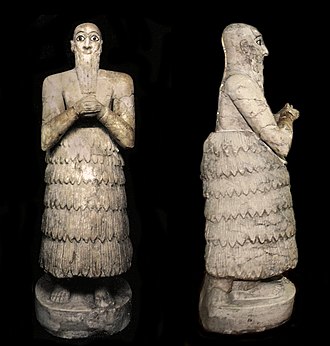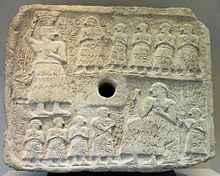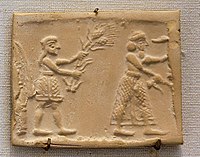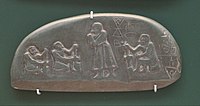Kaunakes

A kaunakes
Background
The origin of this dress is traced to the Sumerian civilization which existed even before 4,000 BC.
Pre-Dynastic period (4000-2700 BC): kilts and "net-dresses"

The earliest type of dress attested in early
-
Cylinder seal from Uruk, with "net-dress", 3100 BC
-
Kilts being worn on the Stele of the lion hunt (3000-2900 BC)
-
A "net dress" being worn on the Blau Monuments (3000-2900 BC)
Early Dynastic Period (2700-2350 BC): kaunakes
The Early Dynastic Period between 2,700 and 2,350 BC was marked by high culture. The dress was a unisex garment which both men and women wore. The skirt was made from sheepskin and was worn with the skin turned inside and with tufts ornamented like a toothed-comb over the wool. It was used in the form of a wraparound skirt tied and worn from the waist extending to the knees.[8] Servants and soldiers wore the shortest garments, while persons of high status wore longer ones[9] with the skirt often extending down to the ankles. The upper part of the body was either covered with another sheepskin cloak spread across the shoulders, or left bare. It was only around 2,500 BC that the sheepskin garment was replaced by a textile made of woven wool; however the tuft part of the dress was continued in the form of "sewing tufts onto the garment or by weaving loops into the fabric". The Greek called this dress kaunakes. This type of dress is featured in sculptures and mosaics of this period.
History
This article or section appears to contradict itself. (March 2024) |

In a Sumerian image dated between 2,900 and 2,600 BC, the dress was worn as a
It is also believed that kaunakes, as a fashioned fleece, while not mentioned prior to 300 BC could be traced to the 400–300 BC. During the Greek period of

In
Purpose
An image dated to about 3rd millennium BC from the Temple of
References
- ^ Sometimes spelled kaunakès, as in French.
- ^ "Sedra". sedra.bethmardutho.org. Retrieved 23 February 2023.
- ^ "The Comprehensive Aramaic Lexicon". cal.huc.edu. Retrieved 23 February 2023.
- ^ http://translate.enacademic.com/γαυνάκης/el/[permanent dead link]
- ^ Chicago Assyrian Dictionary, Volume 5 (PDF). p. 134.
- ^ ISBN 978-1-136-21911-5.
- .
- ^ "Dress". Encyclopædia Britannica. Retrieved 30 November 2015.
- ^ Tortora & Eubank 2010, p. 24.
- ^ "Mesopotamia Review". College of Fine Arts – Illinois State University. Archived from the original on 8 December 2015. Retrieved 30 November 2015.
- ^ Liñeiro, Mirta. "El traje en el Próximo Oriente antiguo. Mesopotamia. Kaunakes". Reflexión Académica en Diseño y Comunicación Nºxix (in Spanish). Año XIII, Vol. 19, Agosto 2012, Buenos Aires, Argentina. Sitio Estudiantes DC – Universidad de Palermo: 57–58. Retrieved 30 November 2015.
- ^ Forbes 1971, p. 9.
- ^ Miller 2004, p. 154.
- ^ Miller 2004, p. 171.
- ^ "images". Getty Images. Archived from the original on 23 April 2019. Retrieved 30 November 2015.
- ^ "A traditional garment worn in an unusual way". Louvre Museum. Retrieved 30 November 2015.
Bibliography
- Forbes, R. J. (1971). studies in ancient technology. Brill Archive. p. 9. GGKEY:R5RHS1HQD3Z.
- Miller, Margaret C. (2004). Athens and Persia in the Fifth Century BC: A Study in Cultural Receptivity. Cambridge University Press. ISBN 978-0-521-60758-2.
- Tortora, Phyllis G.; Eubank, Keith (2010). Survey of Historic Costume. New York: A&C Black. ISBN 978-1-56367-806-6.
Further reading
- Legrain, L. (1940). "Book Reviews: Le Kaunakès by Emile Cherblanc". American Journal of Archaeology. 44 (1): 150–2. JSTOR 499598.
- Crawford, O. G. S. (1926). "The Birthplace of Civilization". Geographical Review. 16 (1): 73–81. S2CID 163250399.
- Corbiau, Simone (1936). "Sumerian Dress Lengths as Chronological Data. An Indo-Sumerian Cylinder". Iraq. 3 (1): 97–103. S2CID 130526762.
- Langdon, S. (2011). "V.—Sumerian Origins and Racial Characteristics". Archaeologia. 70: 145–54. .
- Taha, Munir Y. (1973). "The Authenticity of a Sumerian Statue". Iraq. 35 (2): 151–3. S2CID 193099592.
- Dimand, Maurice S. (June 1945). "A Sumerian Sculpture of the Third Millennium B.C.". The Metropolitan Museum of Art Bulletin. 3 (10): 253–6. JSTOR 3257188.
External links
 Media related to Kaunakes at Wikimedia Commons
Media related to Kaunakes at Wikimedia Commons



